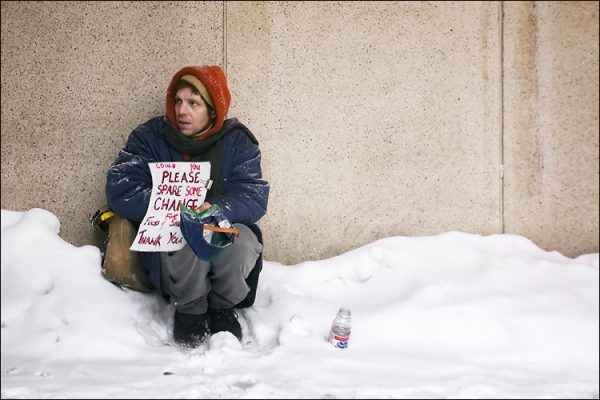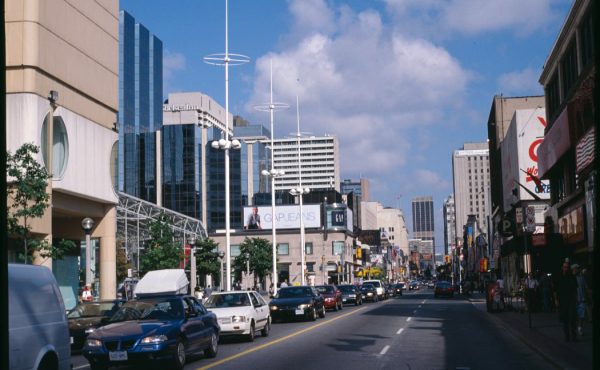Should the City of Toronto declare a housing and homelessness emergency?
Reports on deaths of homeless people, increasing levels of housing unaffordability and rising homelessness indicate that the City should take this step. But a joint statement from the Office of Emergency Management and the Shelter, Support and Housing Administration implies that such a move is unnecessary and pointless.
In the midst of the unusually early cold snap in mid November, well known homeless activist, author and filmmaker, Cathy Crowe reported on Facebook that there were 6,757 individuals staying in the shelter system and another 695 in 24 hour respite sites, 24- hour women’s drop-ins and the Out of the Cold (OOTC) program, for a total of 7,452.
That number sadly, does not include those mostly unquantifiable homeless individuals who either refuse to stay in the shelter system and/or were unable to access one of the above mentioned emergency sites. We usually only hear about them when they die while sleeping outside in the dead of winter.
So far eight deaths have already been reported. At this rate, the death toll might even exceed the roughly 90 annual homeless street deaths recorded in 2017 and 2018.
Staying in a homeless shelter is no guarantee of increased longevity either. In 2018, 23 men and three women died while staying in homeless shelters, according to city statistics. As of November, 2019, that figure has almost doubled, to 36 men and nine women.
But is increasing public awareness of homeless deaths due only to the consciousness raising of well known activists like Cathy Crowe, or is it also due to Toronto’s overall homeless problem simply getting worse? Fred Victor estimates that there are 9,200 homeless Torontonians on any given night and cites increased housing unaffordability over the past decade as the primary cause.
So how do current homelessness rates and market rent rates compare with those of 2009?
A 2013 report published by the Wellesley Institute states that between 2006 and 2009, the homeless population increased by 66 individuals annually, from 4,969 to 5,169. However, from 2009 onward, a dramatic spike occurred: the homeless population increased by 4,031 to the current 9,200, or at a rate of about 400 individuals annually.
Commensurate increases in market rent rents have also occurred during the past decade. The average one- bedroom apartment that cost $1,400 a month in 2009 now can cost upwards of $2,400.
There can be little doubt that correlation does imply causation here. Homelessness rates are in fact increasing because of housing unaffordability, but does that justify declaring a housing and homelessness emergency?
According to the City of Toronto’s website, the Office of Emergency Management coordinates major emergency and disaster planning and management…[and] is responsible for the City’s corporate emergency preparedness by developing programs and plans to prevent disasters, if possible and reducing the vulnerability of residents to any disaster that cannot be prevented.”
In its “Issue Description” section, OEM lists “a number of natural hazards such as extreme heat and cold [among other] environmental risks [which] are expected to increase as a result of climate change”.
OEM also admits that “some residents are more vulnerable…to these events due to… socio-economic status, health status…and level of social connectedness.”
We can argue about whether the affordable housing crisis should be included among OEM’s list of “human caused hazards” or whether it constitutes a “disaster that cannot be prevented.” But, we cannot deny the degree to which OEM’s list of “natural hazards” and “environmental risks” apply to Toronto’s homeless population, especially in the context of Toronto’s increasingly early and severe winter weather.
We must also determine whether current housing supports and approaches are sufficient to address the needs of Toronto’s growing homeless population. The Shelter, Support and Housing Administration (SSHA) governs both the shelter system and rent-geared- to-income (RGI) housing. So how is the SSHA responding?
In June, 2019, Toronto auditor general, Beverly Romeo-Beehler published a report on RGI housing in which she identified 2,000 unfilled available housing placements that could have gone to2,000 homeless applicants currently staying in the shelter system, some of whom have been on social housing waiting lists for the past decade.
In other words, there could be 2,000 fewer people in the shelter system and, as a result, 2,000 more available shelter beds had those homeless applicants been effectively prioritized and processed. Those 2,000 freed- up shelter beds would likely be more than enough to accommodate those currently unable to access the shelter system because of overcrowding.
The first step in solving any problem, even a complex societal one like housing and homelessness, is admitting that it exists. Toronto fell far short of fulfilling its affordable housing promise for the previous decade during which homelessness rates and market rent rates doubled. Only time will tell if Toronto possesses a sufficient sense of urgency to fulfill its most recent ten-year promise, the HousingTO 2020-2030 Action Plan.
* * *
I reached out to both OEM and the SSHA as to their respective positions on declaring a housing and homelessness emergency. They replied with a joint statement:
The City is committed to ensuring there are safe and welcoming spaces for people who need them.
Declaring an emergency does not result in the creation of more shelter or housing than is currently being provided. The City has increased services without declaring an emergency and continues to respond to the needs of the city’s homeless population.
In addition to the existing 24-hour respite sites with 414 spaces, the City is opening six new services, adding 485 spaces, for a total of 899 spaces as part of the 2019-2020 winter services plan. This is an increase over the 805 spaces provided last winter, and significantly more service than 2014 when just two services were provided during Extreme Cold Weather Alerts only.
A range of new services are being provided this year targeted to the specific needs of people experiencing homelessness. One example of this service is a temporary response site for refugees/asylum claimants in the Yonge and Finch area. The site will offer spaces for up to 200 adults while freeing 200 beds across the City’s shelter system for other individuals.
In addition to the new centre for refugees, the winter services plan includes the following services, available until April 2020:
- a 50-space 24-hour respite site operated by St. Felix Centre at 25 Augusta Ave.
- 100 additional temporary winter beds at Seaton House, 339 George St.
- 50 additional temporary winter beds at 545 Lakeshore Blvd. operated by Homes First Society
- 85 spaces for single adults in a hotel-based pre-housing program
Toronto’s shelter system has more than 7,100 beds across 63 permanent shelters and motel/hotel programs. Close to 2,400 beds in hotel-based programs are designated primarily to serve families. The City operates 10 shelters directly and provides funding to community agencies for the operation of the remaining 53 shelters. The City has added more than 2,500 shelter beds since 2015.
* * *
John Clapp reports on affordable housing and homelessness for Spacing and Toronto Storeys and was a contributor to House Divided (Coach House Books, 2019). He wrote about being homeless in this city last July for Toronto Life.





4 comments
Read an article about the Edmonton’s homeless and they seem to have curved the epidemic of homelessness perhaps Toronto should follow in their footsteps to save the street people –
Providing shelter space is only a temporary expedient. Toronto needs low income housing that will permit most of the homeless and those living in inadequate to have a place to live. Housing should be a human right.
What it should do is declare an end to the commodification of housing. Why are there people who own more than one house? You only need one.
The homeless and housing issues are across the country and people are dying in the streets of Vancouver BC as well. The housing that is available is affordable however the other issues arising are poor maintenance and non- maintenance issues like maintenance staff leaving vacant units windows open to let the pipes burst and very poor and dangerous situations arising from neglected and abused buildings that aren’t maintained!!